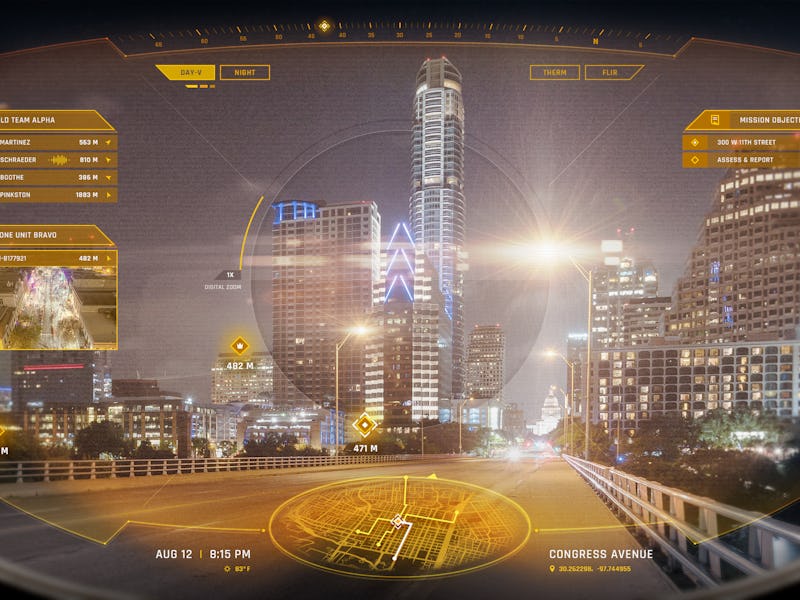'Iron Man'-Like Helmet Has Augmented Reality to Aid Search-and-Rescue Teams
The helmet could offer more vital information faster.

Ready to leap into action, Iron Man-style? Hypergiant Industries took the wraps off its prototype augmented reality helmet Thursday, which can be used by firefighters and rescue teams to help save lives faster.
Project Orion is an active display helmet with a 200-degree field of vision and a 5K resolution. The informational overlay, which gives a heads-up view of the world that could make Tony Stark jealous, offers shape and object detection and classification. Beyond regular vision, the helmet also offers night vision, infrared, thermal imaging and more. The end result is a do-it-all helmet that provides a real-time view of the world and its surroundings.
“The project comes from our R&D team within Hypergiant Industries whose core mission is to be the company’s vanguard of exploration and innovation,” Hypergiant Industries CEO Ben Lamm tells Inverse. “Our ultimate goal is creating technology that will benefit professionals who rely on increased informatics to make decisions in high-pressure situations like the military, astronauts and police officers.”
It’s the latest breakthrough from a firm rapidly making a name for itself with bold, eye-catching announcements that promise to bring sci-fi-like ideas to life. The Austin-based business has six divisions covering machine learning, camera monitoring, and even space-focused solutions. The company’s Galactic Systems division, for example, has plans for an inter-planetary internet, working with the Arch Mission Foundation to store a 30-million page archive of human knowledge in satellites.
Hypergiant Industries CEO Ben Lamm with Project Orion.
Hypergiant Industries lists the hemlet’s potential users as soldiers, firefighters, police, and search-and-rescue teams. Lamm tells Inverse that Hypergiant Industries works both directly with government agencies and through partners such as Booz Allen.
Lance Lord, a retired four-star general that sits alongside Bill Nye and astronaut Andy Allen on the company’s advisory board, noted how the information could help teams make faster split-second decisions:
“In times of stress and when lives are on the line, more data is not helpful. What is most helpful is decision-quality integrated information presented at the right place, at the right time. The results could mean more lives saved and mission accomplished! Hypergiant Industries’ system will match integrated situational information to a decision-maker’s cognitive framework needs. This type of leading-edge technology is what we need to continue to push safety and innovation boundaries.”
The device’s interface is controlled using hand tracking and gestures. The interface combines information from a number of sources, including mounted sensors and networked data sources.
Thermal vision in the helmet.
External data sources that could be fed into the helmet include GPS information, mission briefings, and technical information from other teams. This could cover the location of other team members. It could also view and access information in other helmets, meaning each wearer could help contribute data to complete the mission faster. Command operations units could also send out task updates.
Night vision in the helmet.
The helmet uses a detection module for object classification, based on a proprietary version of RC-NN. This is an algorithm used by artificial intelligence for object classification, which the helmet uses to provide the wearer with a clearer understanding of what they’re looking at. Comparable RC-NNs, the company claims, take around 3,000 lines of code and assume access to a large amount of computing power. Hypergiant’s implementation uses just 500 lines of code and a lower amount of computing power.
Infrared vision.
It’s not the first time that Hypergiant has explored sci-fi helmets to assist professionals. In May, the company debuted the HyperVSR, an astronaut helmet designed to offer vital signs and other information about an ongoing mission. CEO Ben Lamm told Futurism that the helmet helps astronauts to “quickly gather information about a situation, as well as assess their own health, for enhanced decision-making even during emergencies.”
Recreating the technologies from Iron Man is a theme that crops up on occasion, as Tony Stark’s do-it-all suit offers an imaginative combination of augmented reality and user protection. The U.S. Navy has explored an augmented reality diving helmet, while other teams have been working on a robotic exoskeleton called TALOS. British inventor Richard Browning built a suit with six jet engines to give him flying abilities, which later sold in department store Selfridges for nearly $500,000.
Project Orion is still in the prototype stage for now, but the company claims it’s considering development in 2020 alongside other related “Active Display” technologies.
“The Project Orion helmet is now a working prototype that we are now using to demo to some of our strategic defense partners to gain feedback on both functionality and additional use cases,” Lamm tells Inverse. “Based on the feedback, we will continue to refine the software and hardware while we starting working with manufacturing partners in 2020.”